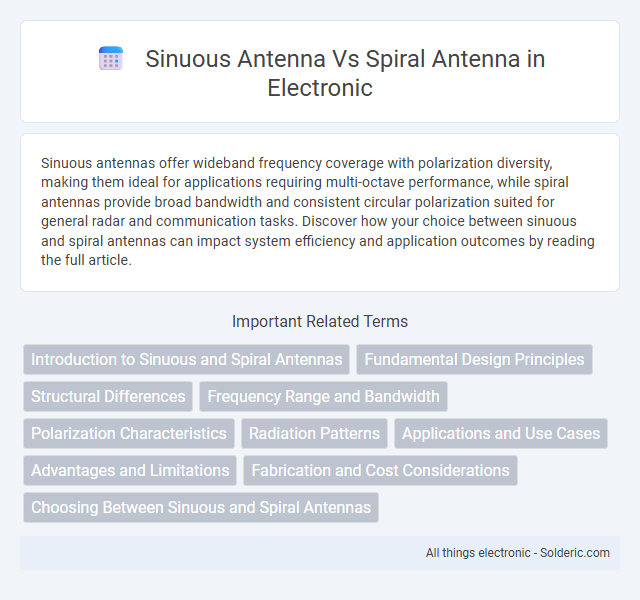Sinuous antennas offer wideband frequency coverage with polarization diversity, making them ideal for applications requiring multi-octave performance, while spiral antennas provide broad bandwidth and consistent circular polarization suited for general radar and communication tasks. Discover how your choice between sinuous and spiral antennas can impact system efficiency and application outcomes by reading the full article.
Comparison Table
| Feature | Sinuous Antenna | Spiral Antenna |
|---|---|---|
| Design | Multi-arm, self-complementary, bent-line structure | Planar, continuous spiral geometry (Archimedean or logarithmic) |
| Bandwidth | Ultra-wideband (UWB) covering several octaves | Wideband, typically 3:1 to 10:1 frequency ratio |
| Polarization | Dual or circular polarization capability | Supports circular polarization with directional control |
| Radiation Pattern | Stable, broad beamwidth with low cross-polarization | Directional, spiral beam with frequency-dependent beamwidth |
| Gain | Moderate, typically 5-8 dBi | Moderate to high, 6-10 dBi depending on size |
| Impedance | Constant ~100 ohms across bandwidth | Moderate, varies with frequency; often 50 ohms matched |
| Applications | Multiband communication, spectrum monitoring, radar | Direction finding, wideband communications, EMC testing |
| Size | Compact, scalable for high frequencies | Larger aperture required for lower frequencies |
| Complexity | Moderate fabrication complexity | Relatively simple planar fabrication |
Introduction to Sinuous and Spiral Antennas
Sinuous antennas feature a self-complementary, fractal geometry that enables ultra-wideband operation with consistent impedance and radiation patterns, making them ideal for multi-band communication systems. Spiral antennas, characterized by their planar, logarithmic spiral arms, offer broad bandwidth and circular polarization, extensively used in radar and electronic warfare applications. Both antenna types leverage their unique geometric properties to achieve wide frequency coverage and stable radiation characteristics.
Fundamental Design Principles
Sinuous antennas are designed based on self-similar, log-periodic geometry featuring multiple arms that spiral outward with varying widths and angles to achieve ultra-wideband frequency coverage and consistent radiation patterns. Spiral antennas, conversely, utilize continuous, smooth curves forming uniform or Archimedean spirals, emphasizing frequency-independent behavior and circular polarization over broad frequency ranges. The fundamental design difference lies in the sinuous antenna's segmented, angular arm structure for enhanced impedance matching and pattern stability versus the spiral antenna's smooth curves prioritizing broadband circular polarization and simple construction.
Structural Differences
Sinuous antennas feature multiple curved arms arranged in a self-complementary pattern, whereas spiral antennas consist of two or more Archimedean or logarithmic spiral arms extending outward from the center. The sinuous antenna's alternating arm geometry allows for a broader bandwidth and more stable radiation patterns, while the spiral antenna's continuous spiral shape supports circular polarization and frequency independence over a wide range. Your choice depends on desired bandwidth, polarization, and physical space constraints inherent in their structural designs.
Frequency Range and Bandwidth
Sinuous antennas operate efficiently across ultra-wide frequency ranges, typically spanning from a few hundred MHz up to 20 GHz, offering broad bandwidth capabilities suitable for diverse applications. Spiral antennas also provide wide bandwidth, often covering frequencies from about 1 GHz to 10 GHz, but generally exhibit slightly narrower bandwidth compared to sinuous antennas. The sinuous design's multi-arm geometry enables more uniform radiation patterns and enhanced frequency coverage, making it preferable for ultra-wideband communication systems.
Polarization Characteristics
Sinuous antennas exhibit broadband circular polarization with frequency-dependent polarization handedness, enabling dual polarization capabilities across wide frequency ranges. Spiral antennas also offer wideband circular polarization but typically maintain a more consistent polarization sense, making them ideal for applications requiring stable polarization. Your choice between sinuous and spiral antennas should consider the need for frequency agility in polarization or a consistent polarization state across the operational band.
Radiation Patterns
Sinuous antennas exhibit broadband, nearly constant radiation patterns with stable linear or dual circular polarization across multiple octaves, making them ideal for wideband applications. Spiral antennas typically produce a directional, circularly polarized radiation pattern with a frequency-independent beamwidth, advantageous for consistent angular coverage. Your choice between sinuous and spiral antennas depends on whether you need wide polarization diversity or highly directional, stable beam shapes.
Applications and Use Cases
Sinuous antennas excel in ultra-wideband communication systems, radar, and electronic warfare due to their continuous frequency coverage and dual-polarization capabilities. Spiral antennas are preferred in satellite communication, direction-finding, and wideband radio astronomy for their simple structure and stable circular polarization. Both antennas support broadband applications, but sinuous designs offer enhanced polarization agility for advanced signal processing.
Advantages and Limitations
Sinuous antennas offer wideband and multiband capabilities with stable radiation patterns, making them advantageous for applications requiring frequency agility and polarization diversity. However, their complex geometry leads to fabrication challenges and larger size compared to spiral antennas, which are simpler, more compact, and provide bidirectional radiation with consistent circular polarization. Your choice between sinuous and spiral antennas depends on the specific requirements for bandwidth, polarization, size constraints, and manufacturing complexity.
Fabrication and Cost Considerations
Sinuous antennas typically demand more complex fabrication techniques due to their intricate, multi-arm geometry, often requiring precision etching or advanced photolithography, which can increase production costs. Spiral antennas are generally simpler to manufacture with conventional printed circuit board (PCB) processes, making them more cost-effective for large-scale production. Your choice may depend on balancing the need for high-frequency performance with budget constraints, as sinuous designs offer broader bandwidth but at a higher fabrication expense.
Choosing Between Sinuous and Spiral Antennas
Choosing between sinuous and spiral antennas depends on the specific application requirements such as bandwidth, polarization, and radiation pattern. Sinuous antennas offer ultra-wideband performance with dual polarization and stable radiation patterns, making them ideal for radar and communication systems requiring frequency agility. Spiral antennas, known for their simplicity and circular polarization, provide broad bandwidth and are preferred in applications like direction finding and wideband communications where compact design and consistent performance are crucial.
Sinuous antenna vs spiral antenna Infographic

 solderic.com
solderic.com